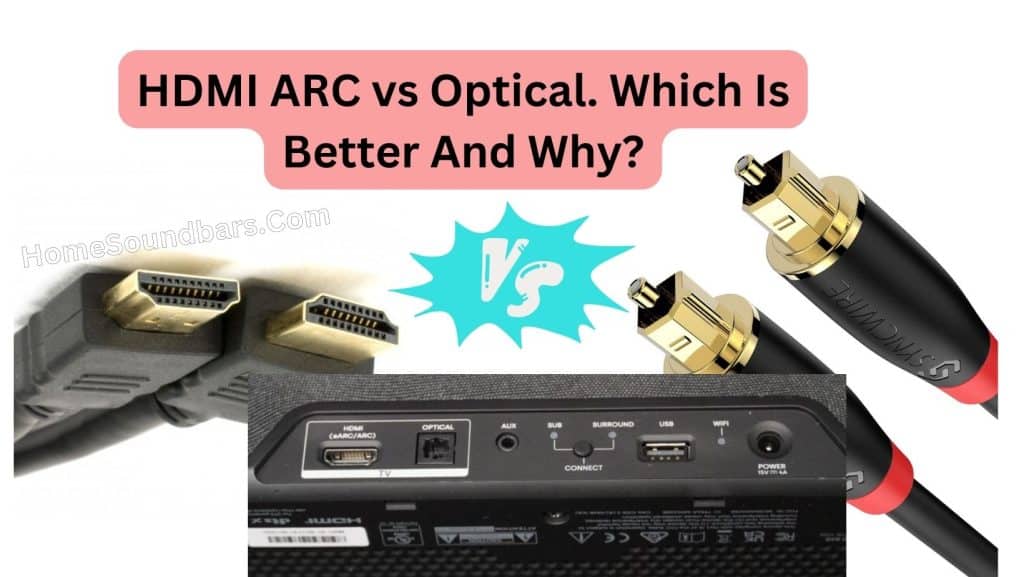
When it comes to soundbars and home entertainment setups, HDMI ARC and digital optical are two of the most popular options. But with all the misinformation out there, it can be hard to decide which one to use. So, let’s clear up the confusion and help you understand the two to help you decide which is better for your system.
HDMI ARC has been around since 2009 and is considered the best option as it offers a few advantages over optical. But optical cables have a few advantages of their own that may make them the better option for you. In this article, we’ll look at both types of cables and compare their benefits and drawbacks.
What Is HDMI ARC?
HDMI ARC stands for Audio Return Channel. Most TVs have a few HDMI inputs, and one of them is usually labeled as ARC. If you have a newer, fancier TV, your TV or soundbar will also even have e-ARC (Enhanced Audio Return Channel), which is even better than ARC.
HDMI ARC works by sending the audio signal from your TV to an ARC-compatible sound bar or audio video receiver. Whether you’re playing Netflix or anything on a smart TV or playing something from a Fire TV, Apple TV, Blu-ray player, etc., the audio signal will still be sent back to the device connected to the ARC port as long as it’s compatible.
Advantages of HDMI ARC over Digital Optical Audio
HDMI ARC offers many advantages over digital optical audio, such as:
- HDMI ARC can handle almost three times more data than optical, allowing for better audio formats.
- Better Sound Quality: HDMI ARC provides superior sound quality compared to digital optical audio.
- CEC (Consumer Electronics Control): With HDMI ARC, you can control the volume and power of both the TV and the external speaker system with one remote controller.
- HDMI Pass-Through. HDMI ARC passthrough allows multiple devices to connect to the TV and still be able to transfer the audio to the soundbar. For example, the TV only has to be plugged into one soundbar with one HDMI cord while having 4 HDMI inputs with a Playstation 5, Blu-ray player, and an Apple TV. All three devices do not have to be plugged into the soundbar; they just need to be plugged into the TV, then the TV passes the audio to the soundbar via HDMI ARC.
What Is Digital Optical?
Optical cables are made of glass fibers and use light to transmit data. This makes them less susceptible to electromagnetic interference than copper-based cables. As a result, optical cables can run over longer distances than HDMI cables. Optical cables can reach distances of up to around 30 meters before needing to be boosted, whereas HDMI over copper is only good up to 15 meters.
Advantages of Digital Optical Audio
- Reliable Connection: Digital optical audio has been around since 1983 and is known for its affordability and excellent audio quality. It is not susceptible to EMI like copper-based HDMI cords, making it a more reliable connection.
- Low Audio Delay: Digital optical cables don’t induce audio delay nearly as much as HDMI ARC does. On certain TVs and soundbars, HDMI ARC can cause the audio to lag behind a bit, resulting in out-of-sync audio and video. This is not a problem with digital optical.
- Longer Maximum Length: Digital optical cables can have a maximum length of around 100 feet, while HDMI cables typically top out at around 50 feet without an active extender. This is due to the low voltage used on HDMI cables, which can cause signal degradation over longer lengths.
- Ideal Setup: Digital optical audio can be a better choice if your existing setup, i.e., TV, sound system, etc., works on digital optical audio and does not have HDMI ARC.
Disadvantages of Digital Optical Audio
- One of the biggest drawbacks of optical cables is that they can’t carry as much data as HDMI cables. As a result, they can’t handle advanced audio formats like Dolby TrueHD or DTS-HD.
- Limited Number of Channels: Digital optical cables can only support two channels of uncompressed PCM audio.
What Are the Limitations of Each?
Digital optical supports up to 5.1 channels with Adobe Digital or DTS Digital Surround Audio codecs. HDMI ARC supports the same, but if you have a newer TV made between 2018 and today, it may support up to 7.1 channels of audio, including Adobe Atmos with the Adobe Digital Plus audio codec.
If you have a 5.1 channel or less surround sound system, it really doesn’t matter which one you use. Both will output a compressed audio stream that’s exactly the same.
However, if you have any upward firing or ceiling speakers that are set as height channels, then you’ll definitely want to use HDMI ARC as digital optical will not support these height channels at all.
The best way to figure this out is to find your TV’s spec sheet or manual and see what audio codecs it natively supports.
Which Should You Use?
When it comes to choosing between HDMI ARC and optical cables, it really depends on your setup and what you need from your entertainment system. However, HDMI ARC is the superior choice when it comes to audio quality when compared to digital optical audio. It’s a great choice if you want the best audio experience. It’s efficient, powerful, and offers multiple features that make it worth considering.
